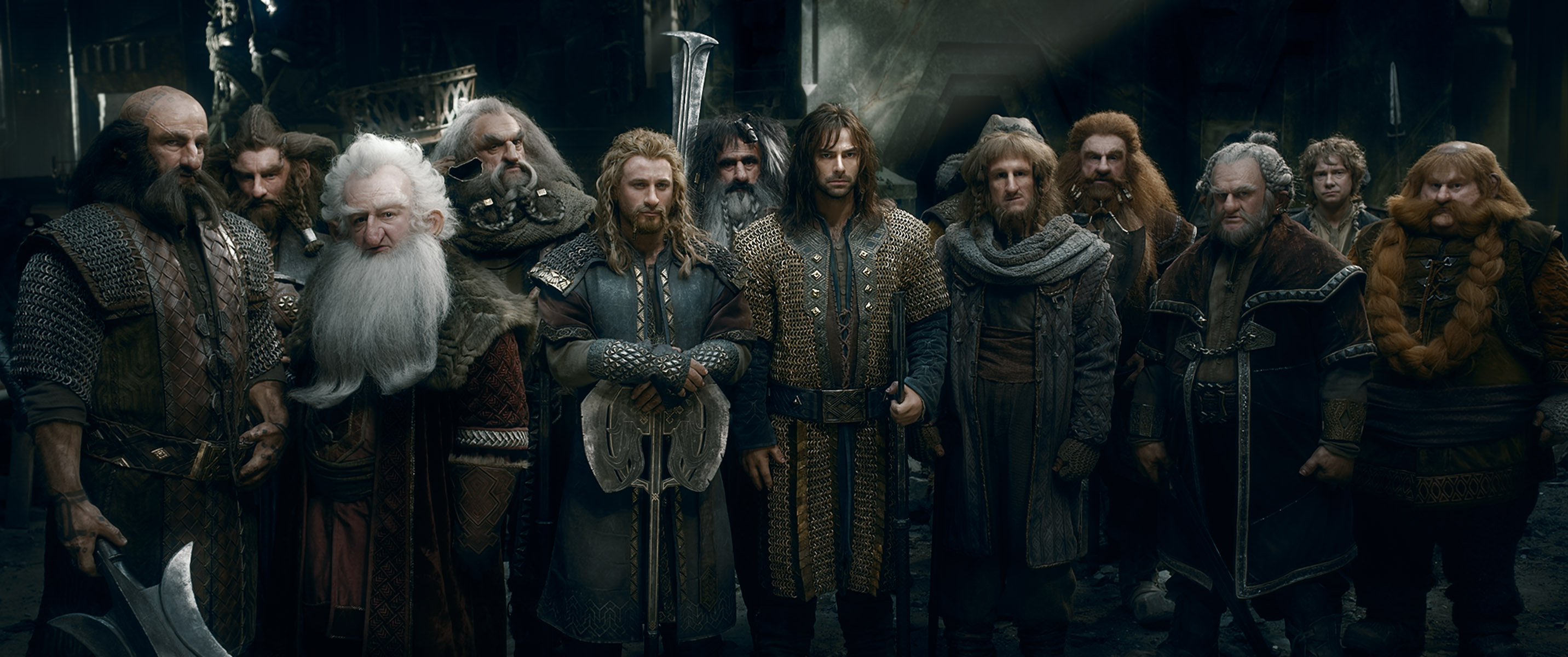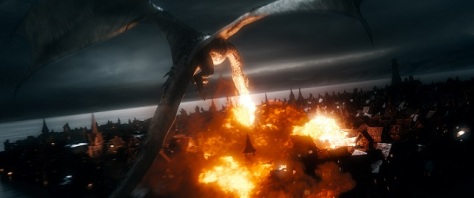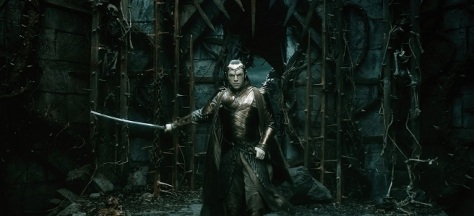Synopsis (Warner Bros.): “The Hobbit: The Battle of the Five Armies” brings to an epic conclusion the adventures of Bilbo Baggins (Martin Freeman), Thorin Oakenshield (Richard Armitage) and the Company of Dwarves. Having reclaimed their homeland from the Dragon Smaug, the Company has unwittingly unleashed a deadly force into the world. Enraged, Smaug rains his fiery wrath down upon the defenseless men, women and children of Lake-town. Obsessed above all else with his reclaimed treasure, Thorin sacrifices friendship and honor to hoard it as Bilbo’s frantic attempts to make him see reason drive the Hobbit towards a desperate and dangerous choice. But there are even greater dangers ahead. Unseen by any but the Wizard Gandalf (Ian McKellen), the great enemy Sauron has sent forth legions of Orcs in a stealth attack upon the Lonely Mountain. As darkness converges on their escalating conflict, the races of Dwarves, Elves and Men must decide – unite or be destroyed. Bilbo finds himself fighting for his life and the lives of his friends in the epic Battle of the Five Armies, as the future of Middle-earth hangs in the balance.
My opinions: Okay, so The Hobbit is done. Thank the Lord, right? Well, actually, it’s a little sad on two fronts. First, it means this is probably the last time I’ll see Thranduil in film (more on him later). Second, the film didn’t really make me feel like the series lived up to the majesty of the original Lord of the Rings series. Let’s get into it.
What I liked:
Thranduil: I can’t tell you how much I love Thranduil. He is the epitome of IDGAF fabulousness in Middle-Earth. He has the most amazing clothes, doesn’t take no ish (even from Gandalf), and will assert his will, no matter who will take offense. I love it all.
Another thing that’s cool about him is that as much as he’d like to assert he’s different from Thorin, they are two sides of the same coin; they’re both selfish, greedy, stubborn people who believe their darkest traits bubble up for noble reasons. At the end of the day, all the two kings are fighting over is gold and starlight diamonds and no one wants to admit that they’re both wrong for it. Yeah, Thorin’s also trying to get his kingdom back, but the motivation for the gold is almost as strong as his motivation to reclaim his rightful throne. I would have liked in the film would have focused less on the bloated battle and more on the similarities the two characters have, which seems to me to be part of their tense relationship. I needed more of Thranduil, but more on that later.
Kili and Fili: Kili and Fili are my two favorite dwarves in the whole thing, with Bofur coming in a close third place. Kili and Fili’s brotherly relationship is so fun and admirable to me, probably because I have a close relationship to my siblings. Spoilers, but I wish they had lived. They deserved to see their kingdom come back to its full glory. But of course, J.R.R. Tolkien felt differently. (But that’s what fanfiction is for!)
Um…is that it? That’s all I can think of right now.
What I didn’t like: (Sadly, this list is longer)
The quick dispatch of Smaug: Okay, so I know that the end of The Hobbit in book-form does contain the killing of Smaug before the final battle, but I still expected the reign of Smaug to last much longer than just the first 15 minutes of the movie (or less). This shows exactly why it makes no sense to break up a story (especially a story contained in one book) into three separate movies.
If you’ve learned about literature in school, you’ve been told that stories have a dramatic structure that, when left untouched, never fails. That dramatic structure being the exposition, rising action, climax, falling action, and dénouement. When studios separate stories into three movies, here’s what happens: the exposition and part of the rising action are contained in one movie, the other half of the rising action and half of the climax are in another, and the last part of the climax, the falling action, and dénouement are in the last movie. When you separate the story from it’s structure, the story falls apart and certain moments lose their power.
This is a long-winded way of saying that most of the Smaug stuff happened in The Desolation of Smaug and we’ve forgotten most of it. When we get to The Battle of the Five Armies, the actual desolation Smaug puts on Lake-Town isn’t as dramatic or soul-gripping as it should be. It’s just a bunch of houses on fire.
But you should just watch Desolation of Smaug again! You might say. Well, sir or ma’am, you just missed the entire point of my argument about story structure. If these movies were set up properly, we wouldn’t be having these problems.
Lack of Thranduil and Bilbo: Look, this is probably just me, but I felt a significant lack of Thranduil. Yes, he fought (and like the graceful, deadly creature he is). Yes, he and his son Legolas had some words, ending with Thranduil looking a mix of embarrassed and hurt. And yeah, Thranduil gave some amazing “Will you get out of my face?” looks at Gandalf, because Thranduil is never here for Gandalf’s “This is important!” speeches. But it still seemed like Thranduil, who’s supposed to be a big player in the movie, wasn’t really in it all that much. I mean, he was in it, but was he really? If you took him out of the movie, you’d see that he didn’t really add much to the proceedings except for being another elf. If he’s really a key player, he should have been much more involved in something, whether it’s a canonical plot point or a plot point that was made up for the film.
But he was big in The Desolation of Smaug! You might say. But again, was he really? I know he imprisoned the dwarves, but apart from that, he didn’t really do much. He’s always in a murky spot in the story — he’s in it enough to semi-justify the amount of time, effort, and creativity that went into is look, extensive wardrobe (much of which wasn’t even seen in the films) and green screen. Example:
This video is why I tweeted the following:
Can there just be a Barbra Streisand-esque Thranduil movie, in which it’s all about clothes, hair & diva-tude? #HobbitBattleOfFiveArmies
— Monique Jones (@moniqueblognet) December 22, 2014
Can you imagine a Funny Girl style film with Thranduil and his whirlwind reign as elf king while changing clothes every camera cut? Insta-classic.
But the time Thranduil spends in the films never really justify all of that creativity and work enough. This argument goes ditto for Bilbo. The story is called The Hobbit, yes? Then why is it that Bilbo is hardly ever in his own story? We know more about Bard the Bowman than we do about Bilbo. Even Galadriel, who was basically shoehorned into this new film series, gets more importance than Bilbo, who is the star of the series. Bilbo isn’t even the star of this review, and the review should be about him. But I know next to nothing about Bilbo. All I know is that he reacts to things in a twitchy way like Tim from The Office aka John Watson aka Martin Freeman.
The queer-coding continues: I wrote in my queer-coding article that Thranduil seems to be played intentionally or unintentionally with tons of camp. Lee Pace is a great actor, and from what I’ve seen of Pace’s acting, Pace does toy a lot of with camp, even when he’s playing an unassuming pie-maker/unwitting Grim Reaper in Pushing Daisies, the “regular guy” role in Wonderfalls or the transgender performer and activist Calpernia Addams in Soldier’s Girl. This is not me passing judgement on his acting style, because he does play his roles with lots of sensitivity; I’m just saying he’s also naturally campy, at least to me. However, it would seem that Pace plays Thranduil with a lot more of a drag style of camp than one might deem necessary.
Of course, comparing Pace’s style of villainy to Jason Isaac’s style of villainy is like comparing apples to oranges, but Issac’s Lucius Malfoy is seething with riches, aloofness, self-importance, cheekbones and hair and yet, he doesn’t come off draggy or camp. Thranduil does. I’m also not passing judgement on drag campiness; I’m just saying that for people to believe Thranduil was semi-evil, his characterization didn’t have to go to drag levels of camp.
I argue against this and yet I’m reinforcing it by saying that I want a Funny Girl Thranduil movie. Sometimes I’m a cog in the system. But it’s not like I’m not being purposefully led down this path. The video alone shows how members of the Hobbit team feel about Thranduil. To them, Thranduil is mostly concerned about hair, shoes, clothes, and appearances aka “girly stuff.” You don’t see Elrond get that kind of coded talk, do you?
How come Thranduil’s characterization couldn’t be focused on the deep love he has for his son and how Thranduil views Tauriel in the scheme of his family? He could have also been a clotheshorse, but at least flesh him out a little bit more. Thre’s so much about Thranduil, Legolas and Tauriel that could have easily filled up its own dramatic film (something else I’d like to see). Also, the queer-coding is even canonized when Thorin’s cousin (the one with the pig) throws some Middle-Earth gay slurs Thranduil’s way. Some more of my tweets:
Thranduil’s queer-coding is even written into the BOFA script, with Thorin’s kingly cousin calling him a “woodland sprite”. — Monique Jones (@moniqueblognet) December 22, 2014
I wanna say Thorin’s cousin called Thranduil a “fairy woodland sprite,” which is even worse. Someone fact-check it for me.
— Monique Jones (@moniqueblognet) December 22, 2014
EDIT: I have seen from some gifs that the pig-dwarf (Dain, as I have learned) says “faithless woodland sprite.” So he didn’t go as far as I thought, but “woodland sprite” still packs a punch.
When I heard this in the theater, I was like, “Okay, so they’re really going to do this like this.” I was a little disappointed, actually. I’d rather think I was reading too much into Thranduil’s character than for the film to basically say, “Yeah, we’re making fun of him because he’s fey to us and that’s something to laugh at.”Again, you don’t see Elrond get this kind of treatment. Sigh. I love Thranduil whether he’s gay, bi or straight, but the film didn’t need to mock his sexuality like that, whatever it may be.
Tauriel being saved by Legolas: First, I should say that I love how Legolas is always worrying about Tauriel, like a big brother should (yes, I said “brother.” More on that later). But the main appeal for Tauriel is that she’s supposed to be the “independent strong woman” quotient of the film. That phrase really doesn’t convey the full breadth of what a feminist character is supposed to mean, but she’s supposed to be the female character, apart from Galadriel, who can hold her own and fight for her people and her freedom. But still, she has to get saved by Legolas in the end, while Legolas literally becomes a video game character, doing impossible things, such as running up crumbling stone.
The same argument I have about Thranduil and Bilbo apply to Tauriel. Why, if she’s supposed to be a big player in this game, get pushed to the sidelines like that? But she was in love with Kili! That’s big! you might say. Is it, though? Was it even necessary? Their love was built on nothing, first of all. Second, what did the love story add to the plot? At the end of the day, it was just a distraction. It was still a sad distraction, but a distraction nonetheless. Am I saying Tauriel couldn’t have had anyone in the film? No…but what I am saying is that the love story could have at least been better developed.
Also, her undefined relationship with Thranduil should have been explored more. It’s like the film is expecting us to know exactly who she is to Thranduil, or that we’ve read all the background on blogs. Before the second film came out, I’d read that Tauriel was something akin to Thranduil’s adopted daughter and that she was raised as such, despite also being raised to know that she was of lower elf status. In elf terms, she’s a little like Dido Elizabeth Belle; of “low birth” but raised like a noble, and she has to go through hoops to discover her true place in the world. Wouldn’t that have been a much more interesting storyline for Tauriel than the standard storyline for a female character — a love story?
In essence, many characters are suffering from something that most characters in the original Lord of the Rings series didn’t — proper characterization. We were able to spend ample time with most of the characters (except for Arwen) and we learned what made them tick and how they interacted with their peers and the world. These Hobbit films, though, are basically large, expensive sketches of a rough idea. It’s a cool idea, but it needs more meat to it.
The love triangle that wasn’t: Legolas was never in love with Tauriel. Let’s make that clear. If Legolas was actually in love with Tauriel, 1) he would have fought more fiercely for her affections in the face of her love for Kili and 2) it would be gross.
If we’re going with the idea that the backstory is that Legolas was raised in a sibling capacity with Tauriel, all he’d see her as is his sister. He wouldn’t want to marry her; he’d want to protect her from things he feel he has the power to protect her from, including battles and their father. In fact, you see him stand up for Tauriel in front of Thranduil, much like a brother would when a parent is, for whatever reason, being unreasonable.
But he told Thranduil he couldn’t stay after he saw Tauriel mourning Kili! you say. Frankly, I thought he couldn’t stay because he’d just had it out with his father a few scenes before. He realized that he and his father are just too different, even though they still love each other. Thranduil is all about enclosing the elf community; Legolas is all about broadening borders and accepting others, even more so by the time we reach him in The Lord of the Rings and he forges a bond with Gimli. Legolas knows he wouldn’t be happy in Mirkwood when there’s a much wider world out there that he could have a hand in protecting. Even if that theory is wrong, it’s the theory I’m rolling with since Legolas being in love with Tauriel makes no sense to me.
The battle itself: Too many armies! Too many factions! Why was Thorin’s cousin CGI when literally everyone else was real? There were tons of moving parts, but the entirety of the battle didn’t have the same emotional depth as any of the battles in the Lord of the Rings series, particularly the Battle for Helm’s Deep. The only moments this film captured some of the intimacy of Rings battles was when characters were fighting one on one and you saw real consequences happen.
Also, since he was part of the battle, Alfred was largely unnecessary. We didn’t need comedy for this, I don’t think. Unless it was Legolas-Gimli-style “Let’s count who we’ve killed” comedy, which actually fits a battle.
Overall, I give the film a 3 1/2 out of 5 stars. I’m glad the series is over and I’m interested to see how else New Line Cinema, Warner Bros. et al. will keep the cash cow of the Tolkien franchise alive. But I just wasn’t as moved as I wanted to have been. I was saddended by Kili and Fili’s death and Bilbo’s heartfelt reaction to Thorin’s death, but the battle just felt bloated, and afterwards, I just felt really tired.
What did you think?
Photo credit: Warner Bros. (except for one Thranduil screengrab by me)








